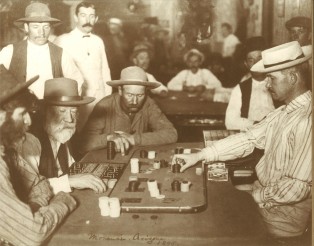 American’s oldest diversion deteriorated into a vice. In the turn of a card or the roll of a dice for all or nothing, there was a kind of daring that touched the American spirit. “The lust for work is matched…by the lust to gamble.” The affluent risked thousands of comforts; the poor risked bread money on gaming tables in slum taverns. The gambling fever produced two opposing species. First were the predatory card sharps and confidence men who understood human weakness and how to exploit it; second were the masses, eternally gullible to the lure of something for nothing. Throughout the nation these adversaries met-in lotteries, over tables, at racetracks, in casinos, cockpits-and the result was nearly always the same. The suckers lost. In 1890, San Francisco had an estimated 2500 illegal gambling houses, which produced, as they did elsewhere, crime and degeneracy. And while these are hardly the by-products one would expect of a leisure activity, it should be remembered that vice can become a pastime for people who had little alternative resource. Starting with the Gold Rush era, the West from the Rio Grande to Canadian border knew no way to spend free hours except gambling. Judge or laborer, clergyman or clerk, all elbowed their way into the gambling tents.
American’s oldest diversion deteriorated into a vice. In the turn of a card or the roll of a dice for all or nothing, there was a kind of daring that touched the American spirit. “The lust for work is matched…by the lust to gamble.” The affluent risked thousands of comforts; the poor risked bread money on gaming tables in slum taverns. The gambling fever produced two opposing species. First were the predatory card sharps and confidence men who understood human weakness and how to exploit it; second were the masses, eternally gullible to the lure of something for nothing. Throughout the nation these adversaries met-in lotteries, over tables, at racetracks, in casinos, cockpits-and the result was nearly always the same. The suckers lost. In 1890, San Francisco had an estimated 2500 illegal gambling houses, which produced, as they did elsewhere, crime and degeneracy. And while these are hardly the by-products one would expect of a leisure activity, it should be remembered that vice can become a pastime for people who had little alternative resource. Starting with the Gold Rush era, the West from the Rio Grande to Canadian border knew no way to spend free hours except gambling. Judge or laborer, clergyman or clerk, all elbowed their way into the gambling tents.
Follow Me
© 2025 Chris Enss | Privacy Policy | Design by Winter Street Design Group | Login

